How do you choose the most suitable wood glue, you ask? Many people new to woodworking are surprised at the strength of today’s wood glue. In fact, when using high-quality wood glue for the application, the cured wood glue joint will be stronger than the wood being joined. In other words, it’s more likely the wood will break before the wood-glued joint fails.
So, what’s the suitable glue to achieve these results? Well, it depends on what wood you are gluing, and how the finished project will be used. With this in mind, let’s look at some of the most popular wood glues on the market. There are five main types of wood glue used in woodworking:
- PVA (Poly-vinyl acetate)
- CA (Cyanoacrylate)
- Epoxy
- Polyurethane
- Hide
This blog will first focus on PVA wood glue, as this is by far the most prevalent type of glue used in woodworking. Then, the four other wood glues will be touched upon, followed by a list of definitions that help your glue and adhesive shopping.
PVA Glue
Polyvinyl acetate (PVA) wood glue is perfect for basic woodworking projects. It’s inexpensive, non-toxic, readily available, cleans up with water, has a modest tack (allowing you to reposition workpieces during assembly), and, once cured, is very strong.
Tite-bond offers a complete line of PVA wood glues. Gorilla Glue, known mainly for polyurethane glue, also has a PVA wood glue. Selecting the suitable PVA glue totally depends on a variety of factors.
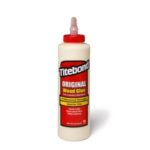
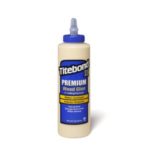
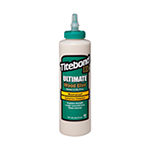
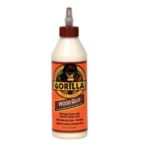
- Tite-Bond Original Wood Glue sets quickly, has a strong initial grab, but is indoor use only.
- Tite-Bond II not only sets quickly and has a strong initial grab, it is also water resistant and can be used indoors or out. What’s more, it’s approved for indirect food contact (such as cutting boards, bowls, etc.)
- Tite-Bond III is waterproof, sets slowly, making it ideal for more complicated glue-ups, and has a lower application temperature which is good for cold workshops.
- Gorilla Woodworking Glue is similar to Tite-bond II. It can be used indoors and out and is also approved for indirect food contact. (Note: do not confuse this wood glue with their popular polyurethane glue.)
The wood glues listed above cover the vast majority of woodworking applications. However, a few specialty PA wood glues are helpful in certain situations.
Specialty Wood Glue
I just wanted to let you know that I need a longer assembly time. Titebond Extend Wood Glue is a slower-setting version of Titebond Original Wood Glue. It is instrumental in complex operations such as curved railings and other assemblies that require more time to align. Moreover, assembly time can be completed in only a full 15 minutes! It is not intended for exterior use or where there is moisture.
Working with dark woods. Titebond II Dark Wood Glue is a dyed version of Titebond II Wood Glue. It helps hide joints in darker woods such as walnut. It provides a strong initial tack and a fast set speed to reduce clamp time.
Concerned about glue running or dripping. Titebond No-Run, No-Drip Wood Glue helps prevent wood glue from dripping and running because it is a thick, fast-drying version. It is ideal for finish trim, crown molding, baseboards, window casings, and other applications requiring professional-strength, no-run adhesives. It provides a strong initial tack and fast set speed yet allows the realignment of working pieces.
CA Glue
Cyanoacrylate (CA) glue is excellent for minor repairs, mainly when carving or turning. This wood glue dries quickly and forms a stiff, plastic-like bond. The liquid form of this wood glue can often run, but this wood glue is also available as a gel that stays in place better. Gorilla Super Glue and Titebond Instant Bond Glue are two good examples.
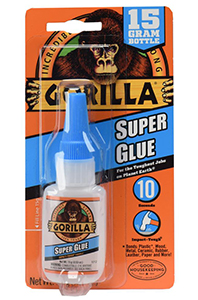
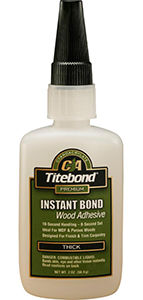
Epoxy
Epoxy comes in two parts: a resin and a hardener. Both are liquid, but a chemical reaction causes the epoxy to harden when mixed. Epoxy has the advantage of being waterproof and does a good job filling gaps in wood. Most other wood glues will not hold well if there is a gap between the pieces of wood you are gluing together. Some epoxy formulas take a while to cure, while others will cure in as little as five minutes. The longer it takes for the epoxy to cure, the stronger the bond will be, so patience is vital.
Polyurethane
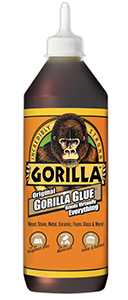
Polyurethane glue is very durable and is often referred to by the trade name “Gorilla Glue.” However, Titebond also makes an excellent polyurethane glue. This type of glue cures in water, requiring you to wet the two mating surfaces before applying. It bonds well to wood and other materials, including plastic, metal, fabric, etc. As it cures, this glue tends to expand. And since it is hard to remove, ensure any glue squeeze-out is quickly removed. Polyurethane glue is an excellent choice for outdoor furniture applications and places that need a powerful bond.
Hide Glue
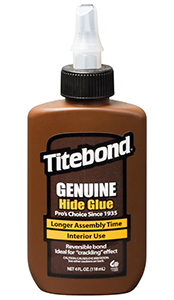
Yes, this glue comes from animal hides. Hot hide glue is made by heating granules of hide glue in a pot with water. As it heats, the glue liquefies, and as it cools, it becomes solid. The biggest reason for hide glue’s popularity is its reversibility. If you apply heat to the joint, the glue will loosen. Recently, Tite-Bond developed a liquid hide glue that can be used at room temperature. This new glue has the same properties as hot hide glue and has a longer open assembly time.
Wood Glue Features To Consider
Bond Strength: The unit load applied in tension, compression, flexure, peel, impact, cleavage, or shear required to break an adhesive assembly with failure in or near the bond plane. Typically reported in pounds per square inch (psi).
Clamp Time: The period of time that the substrates being glued together need to remain clamped.
Closed Assembly Time: The period of time between putting the glued substrates together and clamping. This time allows for moving the pieces into their final position.
Chalk Temperature: When glue dries, water loss pulls the adhesive particles together with enough force to form a continuous film. If the drying temperature is below a critical point, water evaporation cannot pull the particles together, leaving them in the joint. The dried film in the joint will appear whiter than usual. This is known as “chalking,” the critical temperature is the “chalk temperature.” When chalking occurs, the glued joint loses strength and could result in a failed bond.
Freeze-thaw Stability: The ability of a product to remain usable after it has been frozen and thawed. Some options will have a “cottage cheese” look after freezing. If this happens, shake/stir the glue to the original form.
Open Assembly Time: Period of time between initial glue application and putting the substrates together.
Speed of Set: The rate at which an adhesive can build strength.
Squeeze-out: Adhesive pressed out at the bond line due to pressure applied on the substrates.
Starved Joint: A joint in which there is not enough glue for a proper bond to form.
Storage Life: The period of time during which a packaged adhesive can be stored under specified temperature conditions and remain suitable for use.
Tack: The property of an adhesive that enables it to form a bond of measurable strength immediately after the adhesive and substrate are brought into contact under low pressure.
Total Assembly Time: The period of time between the initial glue application and clamping.

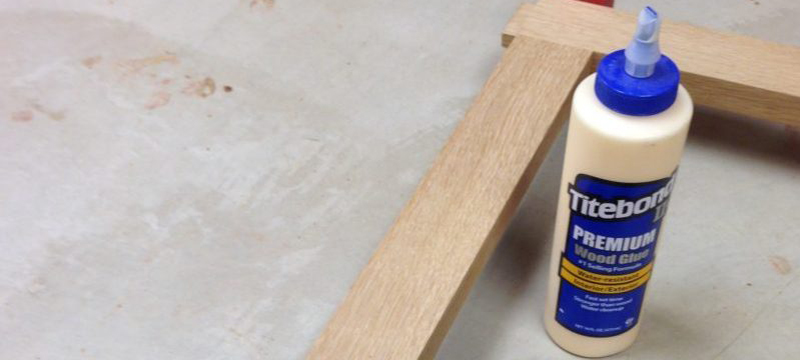
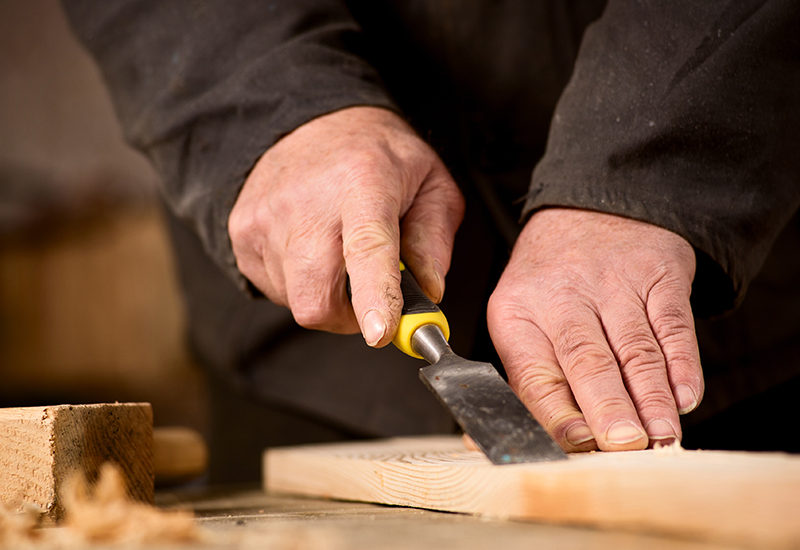


10 Comments
claira
September 24, 2019 at 7:03 amnice and informative blog, but can you tell me how should i properly store the glue for a longer period of time.
Acme Tools
September 24, 2019 at 7:43 amHi Claria, Thank you for your comment and question. The storage procedure all depends on the type of glue you have. We would recommend checking the label to the glue or the manufacturer’s website for more information.
Thank you,
Acme Tools
Ben
February 9, 2020 at 10:26 amthanks for the useful post. A final comparison of the listed glues would be helpful.
It sounds like PVA is the best for most projects, but are there any advantages to using Cyanoacrylate, Epoxy, or Polyurethane?
Acme Tools
February 10, 2020 at 8:23 amHi Ben, Thank you for your comment and your question. The advantages of Cyanoacrylate (CA) glue, Epoxy, and Polyurethane are explained in the blog post.
Thank you,
Acme Tools
Bryan E. Keeton
February 10, 2020 at 4:45 pmI am looking for a glue or epoxy that I can use to seal the inside of wooden bowls and cups. Is there anything that you guys carry or recommend?
Acme Tools
February 11, 2020 at 8:09 amHello, We do not carry wood finishes at this time but if you plan to have food in the bowl or drink from the cup please make sure to use a food safe product. A quick Google search will provide you with many options and you can choose the one best for your needs.
Thank you,
Acme Tools
Len Lockmuller
April 11, 2020 at 12:05 pmWould you kindly recommend a suitable adhesive (glue) to bind 3/4 inch veneers of Pine, for a ‘Wake’ board. The finished board will be coated with an Epoxy type solution for water-proofing. The veneers will be cut to shape so
there is no curvature tension. Thank you. Len
KellyGree
January 7, 2021 at 8:06 amAppreciate your work sir very informative post I have some questions can you answer them?
How can I properly store the glue for a longer period of time.?
And which is the best glue or epoxy that I can use to seal the inside of wooden cups bowls?
thanks waiting for your answers
Acme Tools
January 7, 2021 at 8:32 amHello, Thank you for your question. There are many different types of glue and many different brands. We suggest you contact the manufacturer of the glue you are wishing to store long term. Most glue and epoxy is designed for attaching 2 or more items together, what you should be looking for is a sealant or finish that is food grade.
Thank you,
Acme Tools
Jehou
November 16, 2021 at 6:40 pmWhat glue is people are commonly use? For bed and wooden sofa use.